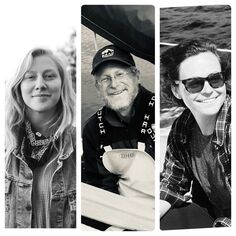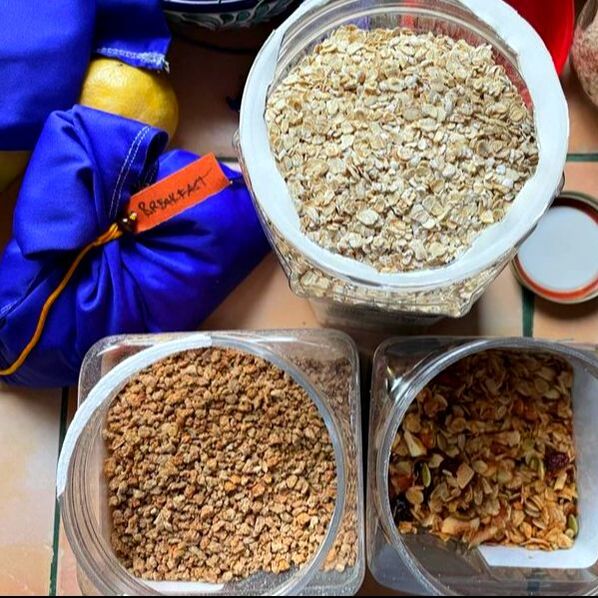|
Today, I realized that a little over six months ago Team Sockeye Voyages crossed the finish line of the 2022 R2AK, the Race to Alaska. For us, for me, the Race really started in autumn 2021. Or 2017, or 2015, watching Team Grin start in the inaugural R2AK. Or perhaps in the beer garden in 2013 when Jake said, “Alaska!”
Since arriving home in late July, it feels like I have been in a different race, a work race, like most people. Except I am a sailor. There was program with Salish Sea Sciences in the San Juan Islands, ASA instruction through San Juan Sailing, the Wooden Boat Festival and R2AK Blazer Party, a ten day trip to Eleuthera to work on the two sharpies of Hurricane Island Outward Bound, to Annapolis to teach at Cruiser’s University, then back to Eleuthera to instruct the sail section of a semester course (with Olivia, Bart, and Morgan), and a visit with my folks at Hatteras. I shoveled some snow at home the week leading up to Christmas. Christmas day, Elizabeth drove me to the airport to fly to where I am, now working on the Corwith Cramer out of St. Croix. Olivia instructed the course out of Eleuthera, too. Tara went cycling in Vietnam! then went to Florida to instruct. All the while, I have though of you, our supporters, wondering how to update you, how to thank you, how to thank you enough. So, I am trying to spill the words out and avoid editing, much. It has been too long. How it wrapped up in Ketchikan, Many of you wondered what happened after we arrived in Ketchikan. Tara departed first, then Olivia, back to Maine to instruct Outward Bound courses. I, Sockeye, remained in Ketchikan for two weeks waiting for the ferry to Prince Rupert to resume operation, halted with the onset of the pandemic. Liz made that workable by loaning me her car. Cal hosted me for a few nights. Jo and Zoe of Team Kairos hosted me for a few nights. Settlers Cove proved a lovely place to camp. A plan, which was offered and accepted, developed from the time we were in Bella Bella/Shearwater. Doug, of Team Pocket Rockanauts drove my car and trailer from Port Townsend to Anacortes. Another friend, Kyle, drove my car and trailer to Prince Rupert and onto the returning ferry to Ketchikan. We disassembled and hauled the boat. We saw bears at the southern extreme of town. We camped at the other end of town. Kyle flew home. I drove the car and boat on trailer onto the next ferry to Prince Rupert. I spent one night there with Ian and Jen, then drove the thousand miles to Anacortes and caught ferry home. While we were working in the Bahamas and dodging tropical storm Nicole, we contemplated, “What is the next thing?” We did not have an answer, but I felt an energy towards something. Sockeye at Christiansted
0 Comments
We are less than three weeks away from the R2AK start, and Team Sockeye Voyages is deep in the preparations for the race: compiling and checking all safety, navigation, communications, and first aid gear; finalizing modifications to our trusty trimaran schooner Mongoose; and gathering and organizing all our food for what we expect to be two to three weeks of travel north to Alaska.
The excited energy and anticipation is palpable as the starting line feels within reach. Over the last week Olivia “Captain Oz” Lord has been spearheading food planning, provisioning, and organizing—supported generously by the kitchen and pantry of Sockeye and Elizabeth’s off-grid home on San Juan Island. Numerous factors including nutrition, calories, weight, and pack-ability are all taken into account and crucial to a good food pack out. All the pre-preparation of meals now will save time and energy on the water, when the rain is pouring down over our tarp cover as we hastily secure our anchor and work to get a hot meal on the stove before catching some much needed and well-deserved sleep. What we’re really excited about when it comes to our food pack-out is the employment of Lichen Bags, made by a fellow Outward Bound Instructor and adventurer, Beth Jackson. Lichen Bags are washable, reusable, waterproof food bags for expeditions and an effective tool for minimizing waste and single-use plastic. Impressively, Beth and three of her friends and co-adventurers, used these bags on a 46-day, 970km canoe trip traversing the Ungava Peninsula in Canada in 2018. Beth hand-made all 200 bags they used from her own original design. Her long-term hope is to create a product that can replace single use plastic bags for food packing in the outdoor programming industry. Using Beth's Lichen bags on our Race to Alaska, we'll be able to field test the bags in a greater variety of conditions and hopefully help Beth to evolve and improve the design. Part of our mission in partaking in this race is to become better stewards of our global and ocean environment. Our hope is to continue to learn to live lightly. We will do so in part by storing approximately 200lbs of our food for breakfasts, snacks, and dinners in 120 of Beth’s Lichen Bags. As a result, we will reduce our waste to near zero when stepping off of Mongoose and onto the docks at Ketchikan. We hope to encourage you too, to be conscious in your adventures of what it means to lighten your impact. And perhaps, get some of your own Lichen bags to use and re-use on future adventures! We are deeply grateful for all those who have supported Team Sockeye Voyages and our race thus far. Lookout for information soon on how best to tune in to our updates and track our progress north! Love and Light from San Juan Island, WA, Team Sockeye Voyages Check out @ohlord247's instagram post for more lichen bag photos! Instagram: @lichenbags Team Sockeye Voyages is Tara,Watkins (“Spoons”), Olivia Lord (“Captain OZ”), and John Calogero (“Sockeye”). The 2022 Race to Alaska is a personal and team challenge through 750 nautical miles of the Inside Passage from Washington State, through British Columbia, to Southeast Alaska. Also, The Race is an opportunity to practice our craft as professional small boat sailors and maritime educators. And, we have offered our vessel as a platform from which to conduct research using our hands and our eyes for scientists interested in various aspects of this particular marine environment.
While we propel ourselves north, we will be conducting research for our scientific partners. Each day we plan to bring the experience to our followers through interactive social media. Watch and listen to us as we struggle with ocean currents while in the rain. Encourage us to overcome challenges. Join us for a plankton tow and when we see whales. Ask us questions. After ringing the bell in Ketchikan, we will turn our bow south towards Washington State following a similar route while continuing our research yet with more exploration for a different experience. Partnering with Dr. Deborah Giles, of Wild Orca, we will log marine mammal sightings for a database which will be available to the public. We can expect to see humpback whales, harbor seals, and stellar sea lions. There is a chance we may see other baleen whales, Pacific white-sided dolphins, and sea otters. Partnering with Dr. Nathan Robinson, of Wild Blue Science, we will record video of what animals are in the water around our boat while underway and when we are at anchor. Dr. Robinson seeks records of behavior and evidence of species that are rare or perhaps never documented before. Partnering with Dr. Robin Kodner, of Western Washington University, we will collect plankton samples en route. Dr. Kodner is seeking distribution and abundance of certain species and with the samples we collect she and her students will look for genetic variations. Partnering with Dr. Leonid Moroz, of the Ocean Genome Atlas Project, we will collect plankton and jellies, specifically ctenophores. The OGAP is looking to collect and sequence many genomes to create a database of life in the ocean now, having witnessed and anticipating more species loss. When compared to the diversity found in tropical rainforests, there is many times that diversity in the oceans and much less knowledge about it. In addition, we plan to conduct some comparative recordings of sounds in the water: our engineless vessel underway, in measured proximity with other engineless vessels, and in measured proximity with powered vessels. Knowledge about the effects of sound on species in the ocean has begun, but more is needed. And, we will collect water samples for a study of the distribution of microplastics along the coast. We are in discussions about partnerships with researchers on these subjects. Based in Port Townsend, Washington, the Northwest Maritime Center runs The R2AK, and other adventure races. The Race Committee is crafting bios which poke fun at each team. Enjoy the bio for Team Sockeye Voyages and the other teams stepping up to this challenge. Thank you for your interest in Team Sockeye Voyages, and we appreciate your support! From a little boat in the Race to Alaska, what can be learned about the marine environment?
Sailors are physical oceanographers and meteorologists. Is the current on the other side of this channel more favorable to get to us Ketchikan? What are the conditions going to be as we sail past this ebbing inlet with a swell from the southwest and fresh breeze from the west? Yet, there are so many other questions. What does that change in water color mean? What makes the crackling sound I hear through the hull in this anchorage? What does the presence of a pod of Pacific white-sided dolphins signify? We are partnering with marine scientists to collect useful data about the waters we sail through and species we encounter. At this moment we are partnered for projects with the following scientists: Dr. Deborah Giles, https://www.wildorca.org/ Dr. Nathan Robinson, https://linktr.ee/wild.blue.science Dr. Robin Kodner, https://kodnerlab.wordpress.com/research/ What do you want to know? Please post in the comments. Thank you for supporting our project. Sockeye "Sockeye, I really want to do the Race to Alaska."
For me, those are wonderful words, energizing and activating words. Last summer, I heard them from Tara Watkins and Olivia Lord. Since the beer garden meeting where Jake Beattie came up with the idea in 2013, since good friends crossed the crowded starting line of the first race in 2015, I live in a constant state of wanting to participate in the Race to Alaska. When Ernie Baird asked me to join him and Martin Musson on Team Grace B for 2017, I felt honored. From that moment onward I wanted to pay that feeling and experience forward. With enthusiasm Tara, Olivia, and I plan and progress, already sharing this experience, just as Ernie enabled a wonderful experience for Martin and myself. While Jake hoped 10 of his adventurous friends would sign up for The Race in 2015, 40 teams registered. Jake and Daniel have created an expanding supportive community, a village of voyagers. I underestimated the breadth and depth of emotions delivered by The Race (as it was called in B.C. during 2017) and the return passage in company with wonderful shipmates, through unplanned crossings and meals with gracious fellow racers, and encounters with supporters ashore and underway. Many have become friends. All welcome connection across teams, across years of The Race, a fellowship of shared experience, as if we were all aboard the same vessel. Perhaps we recognize that we are all sailing together. Sockeye (John Calogero) 29 January 2022 |
AuthorsSockeye Archives
May 2022
Categories |




 RSS Feed
RSS Feed
